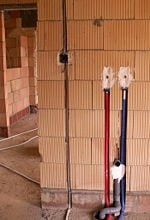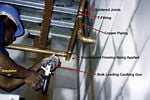Plumbing

Plumbing (from the Latin word plumbum, meaning "lead") is the skilled trade of working with pipes, tubing, and special fixtures for the distribution and use of water in a building and the drainage of waterborne waste. The term plumbing also refers to the pipes and fixtures that are part of such a system. Plumbing is usually distinguished from water and sewage systems, in that a plumbing system serves one building, whereas water and sewage systems serve a group of buildings or a city.
A plumber is a person who installs or repairs piping systems, plumbing fixtures, and equipment such as water heaters. The plumbing industry is a basic and substantial part of every developed economy, due to the need for clean water and proper collection and transport of wastes.[1]
History
Standardized earthenware plumbing pipes with broad flanges making use of asphalt for preventing leakages appeared in the urban settlements of the Indus Valley Civilization by 2700 B.C.E.[2] Plumbing originated during the ancient civilizations, such as those of Greece, Rome, Persia, India, and China, as they developed public baths and needed to provide potable water and drainage of wastes. Improvement in plumbing systems was very slow, with virtually no progress made from the time of the Roman system of aqueducts and lead pipes until the nineteenth century. Eventually, the development of separate, underground water and sewage systems eliminated open sewage ditches and cesspools.
Equipment
Plumbing equipment includes items such as water meters, pumps, expansion tanks, backflow preventers, filters, water softeners, water heaters, heat exchangers, gauges, and control systems.
Pipes and tubes
In a plumbing system, water flows mainly through pipes and tubes. A pipe is typically formed via casting or welding, whereas a tube is made through extrusion. A pipe normally has thicker walls and may be threaded or welded, whereas tubing is thinner-walled and requires special joining techniques such as 'brazing', 'compression fitting', 'crimping', or (for plastics) 'solvent welding'.
Fittings and valves
In addition to pipes and tubing, plumbing systems require many fittings, such as valves, elbows, tees, and unions.
Fixtures
Plumbing fixtures are designed for end-users. Examples of fixtures include water closets (also known as toilets), urinals, bidets, showers, bathtubs, utility and kitchen sinks, drinking fountains, ice makers, humidifiers, air washers, fountains, and eye wash stations.
Materials
In ancient times, water systems relied on gravity for the supply of water, using pipes or channels usually made of clay, lead or stone. Present-day water-supply systems use a network of high-pressure pumps, and pipes are now made of copper,[3] brass, plastic, steel, or other nontoxic material. Present-day drain and vent lines are made of plastic, steel, cast-iron, and lead. Lead is not used in modern water-supply piping due to its toxicity.[4][5]
Systems
The major categories of plumbing systems or subsystems are:
- Potable cold and hot water supply
- Traps, drains, and vents
- Septic systems
- Rainwater, surface, and subsurface water drainage
- Fuel gas piping
For their environmental benefit and sizable energy savings hot water heat recycling units are growing in use throughout the residential building sectors. Further ecological concern has seen increasing interest in gray-water recovery and treatment systems.
Firestopping
Firestopping is required where mechanical penetrants traverse fire-resistance rated wall and floor assemblies, or membranes thereof. This work is usually done by workers in the insulation trade or specialty firestop sub-contractors.
Regulation
Much of the plumbing work in populated areas (cities, towns, and so forth) is regulated by government or quasi-government agencies, due to the direct impact on public health, safety, and welfare. Plumbing installation and repair work on residences and other buildings generally must be done according to plumbing and building codes to protect the inhabitants of the buildings and to ensure safe, quality construction for future buyers. If permits are required for work, plumbing contractors typically secure them from the authorities on behalf of home or building owners.
In some parts of the world, however, the plumbing trade remains virtually ungoverned. There are few (if any) systems in place to monitor or control the activities of unqualified plumbers or those home owners who choose to undertake installation and maintenance works themselves, despite the health and safety issues that arise from such works when they are undertaken incorrectly.[6][7]
The World Plumbing Council (WPC) has appointed a representative to the World Health Organization (WHO) to take forward various projects related to their joint publication, Health Aspects of Plumbing.[8]
Recent advances
Plumbers can now take advantage of technologically advanced equipment that helps them fix problems without the usual hassles. For example, plumbers may use video cameras for inspections of hidden leaks or problems, and they may use hydro jets and high-pressure hydraulic pumps connected to steel cables for trench-less sewer line replacement.
See also
Notes
- ↑ History Channel (Television network), Arts and Entertainment Network, and New Video Group, Plumbing: The Arteries of Civilization Modern Marvels (New York: A & E Television Network, 1998).
- ↑ Teresi 2002
- ↑ Copper Tube Handbook, the Copper Development Association (New York, 2006).
- ↑ Uniform Plumbing Code, IAPMO.
- ↑ International Plumbing Code, ICC.
- ↑ Health Aspects of Plumbing World Health Organization. Retrieved July 25, 2008.
- ↑ World Plumbing Council Retrieved July 25, 2008.
- ↑ WPC representative to work with WHO World Plumbing Council.
ReferencesISBN links support NWE through referral fees
- Cory, Steve. 2005. Plumbing 1-2-3: Expert Advice from The Home Depot. Des Moines, IA: Meredith Books. ISBN 978-0696222474
- Henkenius, Merle. 2006. Ultimate Guide to Plumbing: Complete Projects for the Home. Upper Saddle River, NJ: Creative Homeowner. ISBN 978-1580113113
- International Code Council. 2006. International Plumbing Code 2006. Country Club Hills, IL: International Code Council. ISBN 978-1580012591
- Teresi, Dick. 2002. Lost Discoveries: The Ancient Roots of Modern Science—From the Babylonians to the Maya. New York: Simon & Schuster. ISBN 0684837188
Credits
New World Encyclopedia writers and editors rewrote and completed the Wikipedia article in accordance with New World Encyclopedia standards. This article abides by terms of the Creative Commons CC-by-sa 3.0 License (CC-by-sa), which may be used and disseminated with proper attribution. Credit is due under the terms of this license that can reference both the New World Encyclopedia contributors and the selfless volunteer contributors of the Wikimedia Foundation. To cite this article click here for a list of acceptable citing formats.The history of earlier contributions by wikipedians is accessible to researchers here:
The history of this article since it was imported to New World Encyclopedia:
Note: Some restrictions may apply to use of individual images which are separately licensed.

